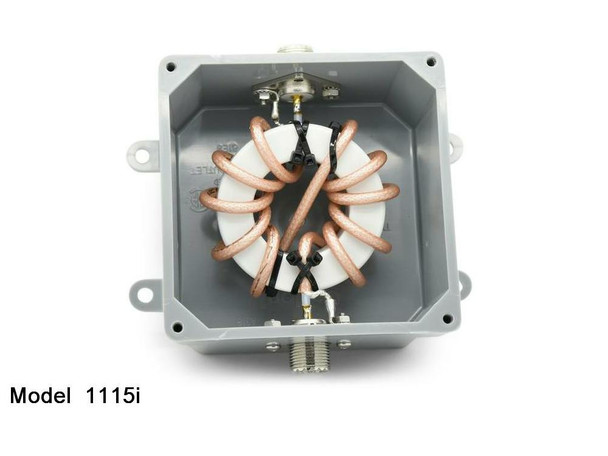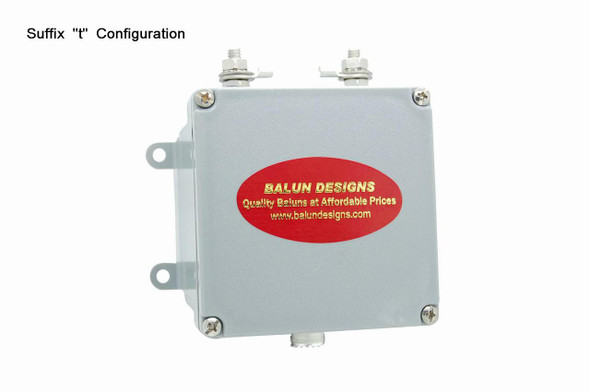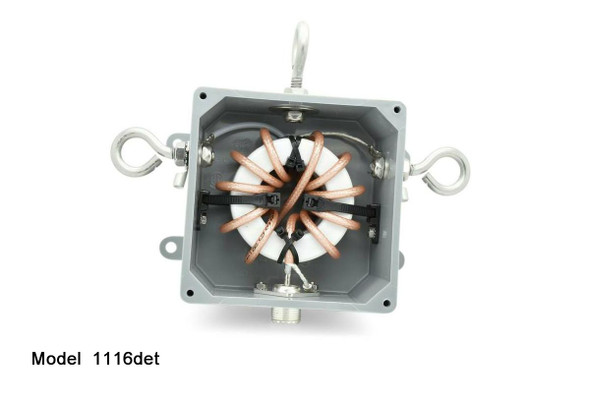Model 1115i - 1:1 Single Core Isolation Balun, 1.5-54 Mhz, 3kW
- SKU:
- 1115i
- Shipping:
- Calculated at Checkout
Description
This is an outstanding new addition to the Balun Designs line of common mode suppression baluns and was developed working in collaboration Fair Rite products, a major ferrite producer. The resulting characteristics of this balun make it what we consider to be the best single core 1:1 common mode suppression balun available today. Looking at the choking impedance (click on righthand thumbnail graph below) you can see why we feel this way. Notice how the level of choking impedance ramps up very quickly developing 3100 ohms on 160m and continues at even higher levels across the full HF spectrum. This is a very difficult level to reach at low frequencies, but even harder for a single core balun to achieve and maintain. In addition, the SWR, transformation and return loss are near perfect. This balun is truly exceptional for a single core design and is the most versatile unit on the market today. This balun is is also available in alternate connector configurations in our model 1115 which utilizes the same outstanding winding configuration.
N connectors and mounting options are available in "Accessories & Connectors" section of our website
If you are using an antenna switch it is important to install an isolation/suppression balun in the main feedline coming into your operating position. The common ground of the switch allows RF/common mode current to come back on the shield of your unused antenna and installing a choke after the switch will suppress any of this before it reaches your equipment.
Our "i" series of feedline isolation baluns provide excellent feedline decoupling and low loss performance from 1 to 54 MHz depending on the model selected. The model 1115i is a single core design that will handle 5kW (50% duty cycle) at resonance and provides high levels of common mode choking impedance and a large effective core area for excellent performance. Balun is configured with two SO-239 connectors with additional RF connectors available in the Accessories Category under Alternate Connectors.
"I want to share how happy I am with the new 1115i balun I purchased from you recently. I was able to complete some antenna repairs last weekend and finally attached the 1115i balun to my inverted V fan dipole. I clearly hear more stations now than I have in at least a year ! The noise floor for me is lower now than it ever has been. Another bonus, I can now happily run my ALS-600 with no problems.
Can't wait to install the other 1115t balun I purchased to my A3S.
Thank you for another great product !!"
When your transceiver and other equipment in your shack acts strangely, it is probably due to stray RF pickup which produces a common mode current problem. This is especially apparent when using end-fed antennas, high-impedance feedlines, or a poor ground counterpoise. Problems can be more evident in SSB mode because the microphone audio line and mic circuitry may be very sensitive to RF. You can even get an RF burn from the mic in worst-case situations, not to mention from the chassis or other equipment used in the system.
If you are experiencing what you suspect to be RF interference, such as fuzzy or distorted transmit audio, interference to video or computer equipment in your house or your neighbors', then it is likely that your feedline is acting as part of your antenna system. While common advice may be to improve the station's RF ground, the root of the problem is poor isolation of the feedline from antenna currents.
Unless you get an actual RF burn or a falult warning message from your transceiver or amp, you MAY NOT KNOW that you have a problem with RF feedback. You should monitor your signal with another receiver or get an on-the-air report. Check your SSB signal on every band the first time you set up a new antenna system, especially if using an antenna tuner. If you do have a problem with RF feedback--typically on one or two bands--reducing power may cure it. However, this is not the best solution and a better way to eliminate RF pickup and induced common mode currents is to electrically isolate the rig from the antenna by using a choke balun more commonly know as a Feedline Isolation balun. This unit can be installed at either the rig or the antenna or in severe cases, at both locations.
NOTE: A traditional voltage balun (various turns ratios, usually wound on a large iron-powder core) will NOT perform the same function as a feedline isolation/choke balun. It will be completely ineffective eliminating RF on a feedline or in your operating position.
Tests run using an AIM 4170uhf network analyzer shows SWR to be below 1.04 across the entire HF band, transformation is perfectly flat, return loss is typically 65-85 dbmw and choking impedance peaks at almost 5k ohms. Please click on the graphs shown below to view the complete test results.


Tests completed utilizing AIM-4170c Network Analyzer and precision 50 ohm non inductive load.
Specifications
| Core Material | Custom mix ferrite by Fair Rite Products for maximum bandwidth. Large 2.4 inch core is coated and sealed for long term durability. |
| Winding Type | Single core, coaxial wound 1:1 current balun |
| Winding Material | Mil Spec 50 ohm coax rated 19kW @ 1MHz, 9kW @ 10 Mhz and 4kW @50MHz. Silver flashed braid and center conductor with solid Teflon dielectric. |
| Power Rating | 1 to 35 MHz - 5kW, 35 to 54 MHz - 4kW. All ratings based on resonant antenna. |
| Useable Frequency | 1 to 54 MHz |
| Insertion Loss | Less than .1db |
| Connectors | SO-239 connectors are gold center conductor with Teflon insulation. Alternate connectors and Mounting Options are available in the Accessories section. |
| Hardware | All Stainless Steel |
| Enclosure Type | NEMA rated 4x marine grade junction box for outdoor installations. Cover has neoprene gasket for weatherproof integrity. |
| Dimensions | 4x4x2 inches for main body of unit Dimensional Drawing of Standard Enclosure |
| Additional Info | Very high efficiency. Will not heat up or saturate at like many of the "less expensive" designs. |








